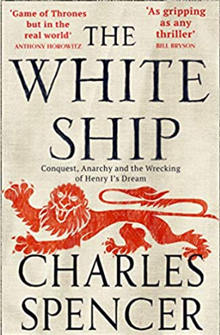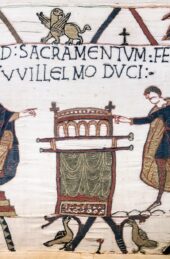When I pitched The White Ship to my publishers (William Collins), I ended with a shorthand reference to celluloid success: “Essentially, this is Titanic meets Game of Thrones – with a hint of Sliding Doors.”
Tragedy, brutal ambition and chance lie at the heart of this historic tale, which has enthralled generation after generation since 1120 – until a generation back, when teachers sadly felt obliged to concentrate on Henry VIII and Hitler, to fill their classrooms.
The White Ship is a timeless tragic tale. The central figure is Henry I, the youngest of William the Conqueror’s four sons, destined for highborn obscurity until the death of two elder brothers in hunting accidents, and the incompetence of the Conqueror’s firstborn son, gave him the opportunity to seize the kingdom of England, and then the dukedom of Normandy. Henry was tough enough to bring peace to his realms, clever enough to promote meritocracy among his leading servants, and canny enough to form the Exchequer, to secure the revenue due to the crown.
Much of his focus was taken up with dynastic planning. While Henry sired 22 illegitimate children, he had just the one legitimate son – William Ætheling, on whose shoulders the future hung. In retrospect, Henry’s mistake was to have an heir, but no spare. At a time of limited life expectancy, this gamble failed: on 25 November 1120, having brought the France of Louis ‘the Fat’ to its knees, Henry and his victorious forces arrived in Norman Barfleur, the port that was favoured for the voyage to Southampton, ready for a triumphant return to England.
In Barfleur, Henry was implored by the captain of The White Ship to take passage on his dazzling vessel. He chose to decline, but committed William Ætheling, as well as two of Henry’s natural children, and many of his greatest generals and courtiers (including 18 ladies of the rank of countess and above) to The White Ship. Passengers and crew got riotously drunk before setting out to sea. On a freezing but still night, the inebriated helmsman miscalculated terribly, and rammed the ship into the Quillebœuf Rock at high speed.
This was at a time when almost nobody could swim. The cold and the waves soon claimed all but Berold, a butcher from Rouen, who scrambled aboard a broken piece of mast, from where he witnessed death all around him, including the heroic end of William Ætheling and his bodyguards.
Henry I bellowed in horrified disbelief at the news of his losses. They say he never smiled again, in the remaining 15 years of his life. The wrecking of The White Ship meant Henry’s legacy was not a male heir, but a contested inheritance that plunged England into one of the bloodiest periods of its history. “The Anarchy” was only ended, after 19 years, by compromise: one that ended the Norman rule of England and ushered in the Plantagenets, who occupied the throne until removed by the Tudors in 1485.
The 900th anniversary of this tragedy is now. It remains the worst maritime disaster ever to have been suffered by England. It has been an enormous privilege to bring it back, in a small way, to public attention.
Charles Spencer is the author of The White Ship: Conquest, Anarchy and the Wrecking of Henry I’s Dream.







